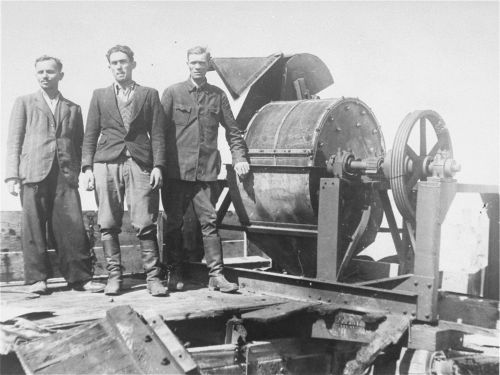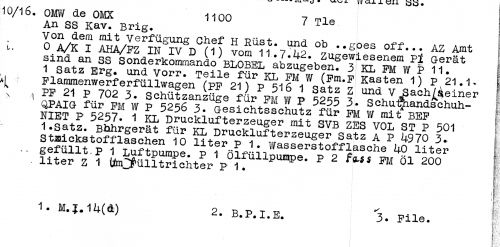Sonderkommando 1005

Janowska Camp Lvov - 3 Men, unknown, David Manusevits and Moses Korn, standing next to a bone mill (USHMM)
The codename of Sonderkommando 1005, had its origins in the file number 1005, used in the related correspondence between Gestapo Chief Heinrich Muller and Martin Luther, who was Head of the Foreign Office's Abteilung Deutschland (Department Germany). The Sonderkommando 1005 were the special units created to implement the large-scale action to obliterate the traces of the mass killings committed by the Nazis in occupied Eastern Europe. The decision to commence this activity was made by Reinhard Heydrich, the head of the Security Services located in Berlin.
In May 1942, Heydrich ordered Paul Blobel, who commanded the Einsatzkommando 4a, who was responsible for the mass murder in September 1941, of the Jews of Kiev, in the ravine known as Babi Yar, to report to him in Berlin, where Blobel was told to report to Opergruppenfuhrer Muller. From then on Blobel's unique assignment was to destroy the traces of mass burials in Poland and Russia.
Paul Blobel arrived in Chelmno on the Ner, Kulmhof in German,on June 12, 1942, in order to determine the most effective method of body disposal to achieve the objectives the kommando had been set. Blobel set to work immediately exhuming the corpses from the mass graves and burning the corpses.

SS -Sonderkommando Blobel - Police Decode 15 July 1942 (National Archives Kew)
During September 1942, Rudolf Hoss the commandant of Auschwitz, along with other members of the SS -Garrison, Franz Hossler and Walter Dejaco visited Chelmno to observe the methods being tested by Blobel. Rudolf Hoss in his memoirs recalled their visit to Chelmno:
Hossler and I went to Kulmhof on a tour of inspection. Blobel had various makeshift ovens constructed which were fired with wood and petrol refuse. He had also attempted to dispose of the bodies with explosives but their destruction had been very incomplete. The ashes were distributed over the neighbouring countryside, after first being ground to powder in a bone mill.
Commandant Rudolf Hoss returned to Auschwitz following this official inspection and copied Blobel's method of burning corpses in the open air, using railway tracks with the bodies stacked on them in a pyre, and set alight using petrol. This method proved so effective that it was also employed at the three Aktion Reinhardt death camps in Poland: Belzec, Sobibor, and Treblinka.
In June 1943, Blobel was back in the Babi Yar ravine in Kiev, which was mentioned beforehand. Blobel's knowledge and experience showed the exhumation squad where to dig. Blobel admitted at the Einsatzgruppen Trial in Nuremburg, that he removed the contents of a mass burial pit measuring sixty yards long and more than eight feet deep.
Leon Weliczker Wells outlined in his memoirs, 'The Janowska Road,' the events of September 7, 1943, in Lvov, about his work in Sonderkommando 1005:
'Beset by these thoughts while the truck speeds forward, we pass Lyczakowska Street, and we turn into the Glinanskej Road and approach the Krzywicki woods. Glinanskej Road shows changes already. Schupos are looking out of the windows of their requisitioned houses, they had moved in yesterday. They must live near the working place, because even when they are off duty, they are on emergency call. In case they hear a shot in the night, they must report immediately. They all belong to our command, which the Germans call Sonderkommando 1005.
A highway leads off Glinanskiej Road, straight through the Krzywicki woods. At the entrance to the woods a guardhouse and ramp have been erected. A private villa in the woods has been commandeered, and it is now the Schupo's kitchen and mess hall. From the villa mess hall one can see our tents. They really do look like a circus from a distance. The truck stops and we are ordered to walk uphill; we go about two hundred and fifty yards to the place where our tents stand, enclosed by two rows of barbed-wire fences, one around the other at a distance of about feet. The two fences have barbed-wire woven between them. The height of the fences is about ten feet. They encircle a square. Each side of this square is about seventy-five feet long.
At opposite sides of the fenced -in area are gates, and near them, on the outside of the fence, are two guardhouses; here the Schupo's stay when it rains. Inside the fenced-in area, at a distance of about eight feet from each side of the fence, stand our two tents, about ten feet apart, facing the gates.
In one corner of our fenced-in area is a field kitchen. Close to this are benches, and on these are basins for washing. In the other corner of the area is an open toilet. Each of the two tents is about twenty-nine feet long by twenty-five feet long, by twenty-five feet wide. One tent holds eighty inmates. The rest of the men will live in the other; they are our elite, the foreman, the group leader, the men who clean the camp and keep it in order, the three leather craftsmen, and some members of the Ash Brigade. I am in this group too.
We are the ones who don't smell, who don't have direct contact with the bodies. One-third of this second tent is separated by a wall, forming a shop on one side. On both sides of the wall are double-decker beds. In the middle of the tent is a long table, and on both sides are benches. We have an electric light here. There are searchlights on all four corners of the barbed-wire fence, lighting up the whole area all night long.
About one hundred and fifty yards away from one side of the camp is a hill of white sand several hundred feet high. This very high hill hides our factory, which changes corpses into ashes. On top of this mountain are two bunkers. To each of these bunkers four Schupo's have been assigned; two sleep, one is at the telephone, while the fourth marches outside, back and forth. In addition to the eight Schupo's on the hill, there are two Schupo's who patrol the area, all night long. Between the sand hill and our camp stands the machine for grinding the bones, and close by the machine, a place has been leveled for the Ash Brigade merely picks the precious metals from the human bone dust.
Because the days are getting shorter, we are now permitted to walk around the yard until eight o'clock. After that time we cannot go into the yard without permission. On one side of the tent the flaps are closed, but on the other side they are always open. One inmate sits guard at the door of each tent at night. These inmates have to report to the Schupo's, who are constantly on guard outside the fence, anyone who goes out to the toilet or gets out of bed during the night. Each Schupo is armed with hand grenades and with a tommy gun that holds three hundred bullets.
At nine o,clock the light in the tent is turned off and everyone must be in bed undressed. Everyone's clothing must lie in clear view on the benches. A man can't escape so easily in his underclothes. At a distance of about seventy-five feet from our tents, in the opposite direction from the mountain of sand, is a tent for the Schupo's. The main ammunition supply is kept there.
On Thursday September 9, 1943, we leave for our first day of work at this new site. There are many graves here, one next to another, starting about one hundred feet from our camp. The corpses in these graves have been in the ground for more than a year. In some of the graves besides the corpses, there are also packages of clothing. We can tell from these packages that the graves contain the victims of the December 1941, 'Aktion at the Bridge of Death.'
At the order of the Untersturmfuhrer we try to build a fireplace with iron grates instead of wooden logs, but under the heat and weight the iron grates bend, and all the bodies cascade down. Since this new equipment doesn't work, we return to the old system, the one we used on the 'Sands.' We build pyres of two thousand or more 'figures,' the name the Germans gave the bodies. They call us 'figures,' too. They say for example, 'zehn Figuren heraustreten' (Ten Figures step out).
Normally we ignite the pyres on Saturday and it usually takes until Wednesday for the heap to be completely burned.
Sonderkommando 1005 activities in the occupied areas got into full swing in the spring of 1943. In the Ukraine, Blobel organised two subordinate units, Sonderkommando 1005A and Sonderkommando 1005B. As well as working at Babi Yar, which has already been mentioned, the units worked at Berdichev, Dnepropetrovsk, Nikolayev, and Uman. In Minsk, Karl Harder, who was Blobel's deputy organised an additional unit, Sonderkommando -Mitte. This unit operated in Byelorussia. Other Sonderkommando 1005 units saw work in the Baltic States.
Most of the German personnel in the Sonderkommando 1005 were assembled in Salzburg, in Austria during October 1944, and were reassigned - again under the command of Paul Blobel - to Einsatzgruppe Iltis, to fight Yugoslav partisans in the area of Carinthia. Einsatzgruppe Iltis fielded two sub-units Einsatzkommando 12 and Einsatzkommando 13.
Sources
G. Reitlinger, The Final Solution, Vallentine Mitchell and Co London 1953
C. Webb and A.Hojan, The Chelmno Death Camp, Ibidem-verlag, Suttgart 2019
C.Webb, The Auschwitz Concentration Camp, ibidem-verlag, Stuttgart 2018
French L Maclean, The Field Men, Schiffer Military History, Atglen 1999
Leon Weliczker Wells, The Janowska Road, Holocaust Library, USHMM 1999
Photograph: USHMM
Document: The National Archives Kew
© Holocaust Historical Society, November 24, 2021

